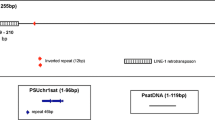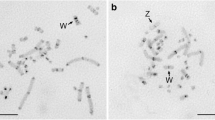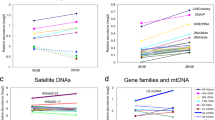Abstract
The genomes of four primate species, belonging to the families Pongidae (chimpanzee, gorilla, and orangutan) and Hylobatidae (gibbons), have been analyzed for the presence and organization of two human GC-rich heterochromatic repetitive sequences: βSatellite (βSat) and LongSau (LSau) repeats. By Southern blot hybridization and PCR, both families of repeats were detected in all the analyzed species, thus indicating their origin in an ape ancestor. In the chimpanzee and gorilla, as in man, βSat sequences showed a 68-bp Sau3A periodicity and were preferentially organized in large clusters, whereas in the orangutan, they were organized in DNA fragments of 550 bp, which did not seem to be characterized by a tandem organization. On the contrary, in each of the analyzed species, the bulk of LSau sequences showed a longer Sau3A periodicity than that observed in man (450–550 bp). Furthermore, only in the chimpanzee genome some of LSau repeats seemed to be interspersed within blocks of βSat sequences. This sequence organization, which also characterizes the human genome, is probably absent in the gorilla. In fact, the analysis of a gorilla genomic library suggested that LSau repeats are not preferentially in linkage with βSat sequences. Moreover, LSau sequences were found in a genomic sector characterized by the simultaneous presence of L1 and (CA) repeats, as well as of anonymous sequences and known genes. In spite of the different sequence organization, the nucleotide differences between complete human and gorilla LSau repeats were very few, whereas one gorilla LSau repeat, interrupted by a probably-truncated L1 transposon, showed a higher degree of divergence. Besides the gorilla, this unusual sequence organization was detected in man, and, to a lesser extent, in the chimpanzee.
Similar content being viewed by others
References
Agresti A, Rainaldi G, Lobbiani A, Magnani I, Di Lernia R, Meneveri R, Siccardi A, Ginelli E (1987) Chromosomal location by in situ hybridisation of the human Sau3A family of repeats. Hum Genet 75:326–332
Agresti A, Meneveri R, Marozzi A, Corneo G, Gaudi S, Ginelli E (1989) Linkage in human heterochromatin between highly divergent Sau3A repeats and a new family of repeated DNA sequences (HaeIII family). J Mol Biol 205:625–631
Aleixandre C, Miller DA, Mitchell AR, Warburton DA, Gersen SL, Disteche C, Miller OJ (1987) p82H identifies sequences at every human centromere. Hum Genet 77:46–50
Assum G, Fink T, Steinbeißer T, Fisel KJ (1993) Analysis of human extrachromosomal DNA elements originating from different β-satellite subfamilies. Hum Genet 91:489–495
Baldini A, Miller DA, Miller OJ, Ryder OA, Mitchell AR (1991) A chimpanzee-derived chromosome-specific alpha satellite DNA sequence conserved between chimpanzee and human. Chromosoma 100:156–161
Baldini A, Ried T, Shridhar V, Ogura K, D'Aiuto L, Rocchi M, Ward DC (1993) An alphoid DNA sequence conserved in all human and great apes chromosomes: evidence for ancient centromeric sequences at human chromosomal regions 2q21 and 9q13. Hum Genet 90:577–583
Caccone A, Powell JR (1989) DNA divergence among hominoids. Evolution 43:925–942
Clemente IC, Ponsà M, Garcia M, Egozcue J (1990) Evolution of Simiiformes and the phylogeny of human chromosomes. Hum Genet 84:493–506
Corneo G, Ginelli E, Polli E (1970) Repeated sequences in human DNA. J Mol Biol 48:319–327
Di Nocera P, Sakaki Y (1990) LINEs: a superfamily of retransposable ubiquitous DNA elements. Trends Genet 6:29–30
Dover G (1982) Molecular drive: a cohesive mode of species evolution. Nature 299:11–117
Durfy SJ, Willard HF (1990) Concerted evolution of primate alpha satellite DNA. Evidence for an ancestral sequence shared by gorilla and human X chromosome alpha satellite. J Mol Biol 216:555–566
Kanno M, Chalut C, Egly JM (1992) Genomic structure of the putative BTF3 transcription factor. Gene 117:219–228
Manuelidis L, Borden J (1988) Reproducible compartmentalisation of individual chromosome domains in human CNS cells revealed by in situ hybridisation and three-dimensional reconstruction. Chromosoma 96:397–410
Manuelidis L, Wu JC (1978) Homology between human and simian repeated DNA. Nature 276:92–94
Marçais B, Laurent AM, Charlieu JP, Roizès G (1993) Organisation of variant domains of α satellite DNA on human chromosome 21. J Mol Evol 37:171–178
Meneveri R, Agresti A, Della Valle G, Talarico D, Siccardi A, Ginelli E (1985) Identification of a human clustered G + C rich DNA family of repeats (Sau3A family). J Mol Biol 186:483–490
Meneveri R, Agresti A, Marozzi A, Saccone S, Rocchi M, Archidiacono N, Corneo G, Della Valle G, Ginelli E (1993) Molecular organisation and chromosomal location of human G + C rich heterochromatic blocks. Gene 123:227–234
Miller DA, Sharma V, Mitchell R (1988) A human-derived probe, p82H, hybridizes to the centromeres of gorilla, chimpanzee, and orangutan. Chromosoma 96:270–274
Prosser J, Frommer M, Paul C, Vincent PC (1986) Sequence relationships of three human satellite DNAs. J Mol Biol 197:145–155
Roizès GP, Pagés M (1982) Tissue specificity and organisation of CpG methylation in calf satellite DNA I. Nucleic Acids Res 10:565–576
Sibley CG, Ahlquist JE (1984) The phylogeny of hominoid primates, as indicated by DNA-DNA hybridisation. J Mol Evol 20:2–15
Sibley CG, Ahlquist JE (1987) DNA hybridisation evidence of hominoid phylogeny: results from an expanded data set. J Mol Evol 26:99–121
Sibley CG, Comstock JA, Ahlquist JE (1990) DNA hybridisation evidence of hominoid phylogeny: a reanalysis of the data. J Mol Evol 30:202–236
Skowronsky J, Singer MF (1985) Expression of a cytoplasmic LINE-1 transcript is regulated in a human teratocarcinoma cell line. Proc Natl Acad Sci USA 82:6050–6054
Sun L, Paulson KE, Schmid CW, Kadyk L, Leinwand L (1984) Non-Alu family interspersed repeats in human DNA and their transcriptional activity. Nucleic Acids Res 12:2669–2690
Tautz D, Renz M (1984) Simple sequences are ubiquitous repetitive components of eukaryotic genomes. Nucleic Acids Res 12:4127–4138
Vogt P (1990) Potential genetic functions of tandem repeated DNA sequences blocks in the human genome are based on highly conserved “chromatin folding code.” Chromosoma 84:301–336
Watanabe H, Sawada J, Yano K, Yamaguci K, Goto M, Handa H (1993) cDNA cloning of transcription factor E4TF1 subunits with ETS and Notch motives. Mol Cell Biol 13:1385–1391
Willard HF, Waye JS (1987) Hierarchical order in chromosome specific human alpha satellite DNA. Trends Genet 3:192–198
Author information
Authors and Affiliations
Additional information
Correspondence to: R. Meneveri
Rights and permissions
About this article
Cite this article
Meneveri, R., Agresti, A., Rocchi, M. et al. Analysis of GC-rich repetitive nucleotide sequences in great apes. J Mol Evol 40, 405–412 (1995). https://doi.org/10.1007/BF00164027
Received:
Accepted:
Issue Date:
DOI: https://doi.org/10.1007/BF00164027




